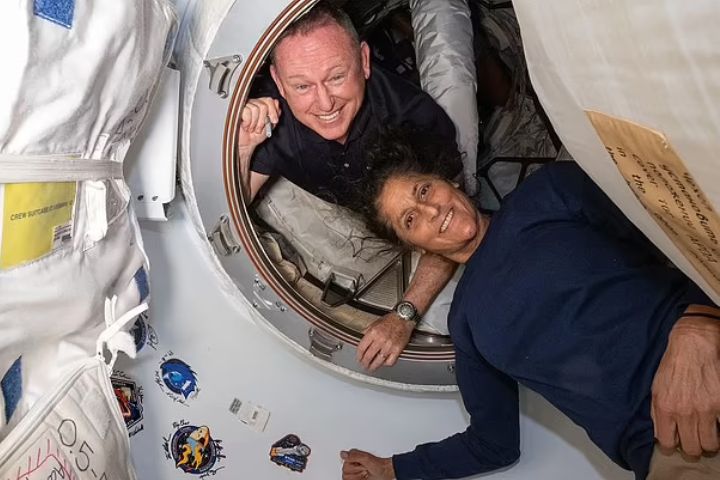NASA astronaut Sunita Williams and her colleague Butch Wilmore have been stranded on the International Space Station (ISS) for over two months, and their situation just became even more precarious. Initially, their return to Earth was delayed due to technical problems with the Boeing Starliner spacecraft.
Now, an unforeseen and potentially life-threatening complication has arisen: debris from a Chinese rocket explosion. This debris is orbiting dangerously close to the ISS, increasing the risk of collision and putting the lives of the astronauts on board at stake.
Prolonged Stay on the ISS
Sunita Williams, an accomplished astronaut of Indian origin, embarked on her mission to the ISS on June 5, 2024. She was expected to return within a few months, but technical issues with the Boeing Starliner, the spacecraft intended to bring her and her fellow astronauts back to Earth, have extended the mission until at least February 2025. The Starliner, a key component of NASA’s Commercial Crew Program, has faced multiple delays and setbacks, which have contributed to the prolonged stay of the astronauts on the ISS.
This extended mission has taken its toll on the crew, both physically and mentally. Living in space for such an extended period can have significant health implications, including muscle atrophy, bone density loss, and exposure to higher levels of radiation. The crew members have been resilient, continuing their scientific experiments and daily routines aboard the ISS. However, the uncertainty surrounding their return to Earth has undoubtedly added to the psychological strain.
Chinese Rocket Explosion: A New Threat Emerges
The situation took a critical turn on August 12, 2024, when a Chinese rocket carrying 18 internet satellites exploded shortly after deploying its payloads into orbit. This explosion was reported to have created over 700 pieces of debris, which are now scattered across a highly trafficked region of Earth’s orbit. According to US space-tracking firms, the number of debris pieces could exceed 900, making this event one of the most significant of its kind.
The debris is now orbiting the Earth at high speeds, posing a collision risk to satellites, space missions, and the ISS itself. The ISS orbits the Earth at an altitude of approximately 400 kilometers, within a region where debris from the Chinese rocket explosion is present. Even a small piece of debris traveling at high velocity can cause catastrophic damage to spacecraft and satellites.
Impact on the ISS and the Crew
The immediate concern is whether the ISS and its crew are in imminent danger from this debris. The US Space Command has issued a statement reassuring that there is currently no immediate threat to the ISS. However, the situation remains volatile, and the debris field could continue to pose a danger for years to come. The crew of the ISS, including Sunita Williams and Butch Wilmore, must now navigate this new threat while already dealing with the challenges of their extended mission.
The debris field created by the Chinese rocket explosion adds a new layer of complexity to space operations. The ISS may need to perform collision avoidance maneuvers, which involve adjusting its orbit to avoid potential collisions with the debris. These maneuvers require precise calculations and can disrupt the routine operations aboard the station. Furthermore, the increased traffic in Earth’s orbit due to the proliferation of satellites and debris heightens the overall risk to future space missions.
The Psychological and Emotional Toll
Being stranded in space with no clear timeline for return is an extraordinary challenge. For Sunita Williams, however, space has always been her “happy place,” according to her husband, Michael. She has spent more than 322 days in space over the course of her career, making her one of NASA’s most experienced astronauts. Despite the challenges, her resilience and dedication to space exploration have been unwavering.
But even for someone as experienced as Williams, the current situation is far from ideal. The crew must maintain a delicate balance between continuing their scientific research and ensuring their safety. The psychological toll of being in such a prolonged and uncertain situation cannot be underestimated. The astronauts have limited contact with their families and friends, relying on communication systems aboard the ISS to stay connected. The knowledge that their return to Earth is uncertain and potentially fraught with danger due to the debris adds to the stress.
The Larger Implications for Space Exploration
The incident involving the Chinese rocket explosion highlights the growing problem of space debris. As more countries and private companies launch satellites into orbit, the risk of collisions and the creation of additional debris increases. Space debris, often referred to as “space junk,” includes defunct satellites, spent rocket stages, and fragments from collisions or explosions. This debris poses a serious threat to operational satellites, space missions, and the ISS.
Efforts are underway to address the issue of space debris. Various space agencies, including NASA, the European Space Agency (ESA), and private companies, are exploring technologies to track, mitigate, and even remove debris from orbit. However, these efforts are still in the early stages, and the challenge of managing the growing amount of debris in space remains daunting.
The situation faced by Sunita Williams and her crew underscores the need for international cooperation in space. The risks posed by space debris are not confined to any one nation; they are a global concern that requires collaborative solutions. As space becomes increasingly commercialized, with companies like SpaceX launching large constellations of satellites, the need for effective space traffic management and debris mitigation becomes even more pressing.





GIPHY App Key not set. Please check settings